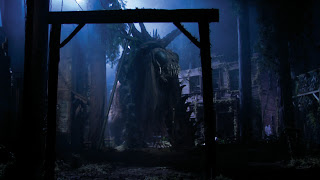
C.H.U.D. feels like a long-lost film from Larry Cohen, who made a career from writing and directing horror and exploitation films set and shot in his native New York. From the Maniac Cop trilogy to Q: The Winged Serpent, Cohen willfully and gleefully captured his city not in any kind of artificial, idealized way, but in the way she actually was then, that is to say…not the kind of place you ♥. Cohen was one of the many attendees of the now-legendary 42nd Street Theater — the planet’s most famous grindhouse theater — which often showed double-bills of the same questionable films he would later grow up to make, and which also inspired Tarantino and Rodriquez to completely misinterpret those films’ appeal when they made their bloated and masturbatory opus Grindhouse.
Even though Cohen had absolutely nothing to do with C.H.U.D., his fingerprints are somehow all over it. With a credited screenplay by Parnell Hall (over Shepard Abbot and actors Daniel Stern and Christopher Curry, who rewrote 50% of the script but received no credit) and directed by Douglas Cheek, C.H.U.D. fits right in with the late ’70s/’80s filmography of Cohen, William Lustig (Maniac), Frank Henenlotter (the Basket Case trilogy), and other New York-based horror filmmakers used to working with low budgets. C.H.U.D. is not only a New York-set story, but its plot/conflict directly addresses an existing problem that the city was suffering with at the time, and likely still is: the staggering amount of homeless people living on and below the streets. C.H.U.D., the silly monster movie about silly looking monsters killing people, and about whom no city officials give a shit, actually has something prescient to say. Unfolding like a budget version of JAWS, C.H.U.D. presents a group of men, some already friendly and some not, who come together to confront the growing threat plaguing their city, even as city officials dismiss their concerns, nearly collapsing the heroes’ campaign in the typical amount of bureaucracy.


Because of this, C.H.U.D. is kind of an ugly film, aesthetically, to look at. Much of the action takes place in underground “caves” below the city, the sewers, soup kitchens, and queasy looking tenement buildings. Even certain scenes, like George (John Heard) and Lauren’s (Kim Greist) apartment, or park exteriors, exude a certain dinginess. C.H.U.D. is a bland looking movie with little dynamism, but that was the point.
For what it is, C.H.U.D. is decently scripted, acted, and assembled, and the monsters’ designs — though later disparaged by the cast — are fun for what they are, and indicative of the decade during which C.H.U.D. was made. Glowing eyes, slimy mouths, and rubber everything, C.H.U.D. was both a callback to the radiation scare films of the 1950s as well as a comment on the then-culture of New York City. It doesn’t exactly unfold at a clip, choosing to establish intrigue and mystery instead of monster hands ripping off human heads (even though that happens), and it’s for this reason that it might not hold an interest for viewers who have yet to have the pleasure. But for those who appreciate a grimy New York horror romp, rubber monster movies, and subtly clever satire, say it with me: C.H.U.D.!


If you decide to add C.H.U.D. to your film library, or if you already own a copy but haven’t yet had the pleasure, I can’t implore you enough to listen to the audio commentary with director Douglas Cheek, writer Shepard Abbott, and actors John Heard, Daniel Stern and Christopher Curry. Because this is the greatest commentary that’s ever been recorded for any film. I’ve long championed this commentary to any film fan who would give half a damn while stressing that there’s no way it doesn’t improve your life. Seriously, it’s great, and everything a commentary should be: it’s enthusiastic, it’s hilarious, it’s informative, but most importantly, it’s honest. This is the most honest audio commentary track you will ever hear — from cast member Daniel Stern booing the name of the credited screenwriter (who is not Shepard Abbot) during the opening credits and adding “that’s BULLSHIT,” to the derision of the final monster designs, which clashes with the original intention of making them more human. (“They look stupid!”) The commentary opens with what sounds like a somewhat drunken voice saying, “Well, yeah, I’m John Heard, I’m in C.H.U.D., and that’s…all there is to it.” Towards the end, Daniel Stern randomly comments on his dirtied character’s appearance as being a “werewolf Bob Dylan,” leading Christopher Curry to totally freestyle an uncanny Bob Dylan impression, turning the film’s action into observational song lyrics, with rhymes and all. No shitting, it’s one of my favorite all-time things. (The track also appears on the newest Blu-ray release from Arrow Video.)
C.H.U.D. shouldn’t be mistaken for being among the best of the ’80s, but it’s certainly admirable and provides a bit of fun. It’s a decent throwback to an earlier era of the genre (and it’s so old that the decade during which it was made has recently become a focal point for a whole new crop of throwback horror films — Jesus, I am old!), and could easily be appreciated by devotees of the low budget New York horror scene.
And if you need a bit more convincing, just remember: he’s John Heard, he’s in C.H.U.D., and that’s…all there is to it.




